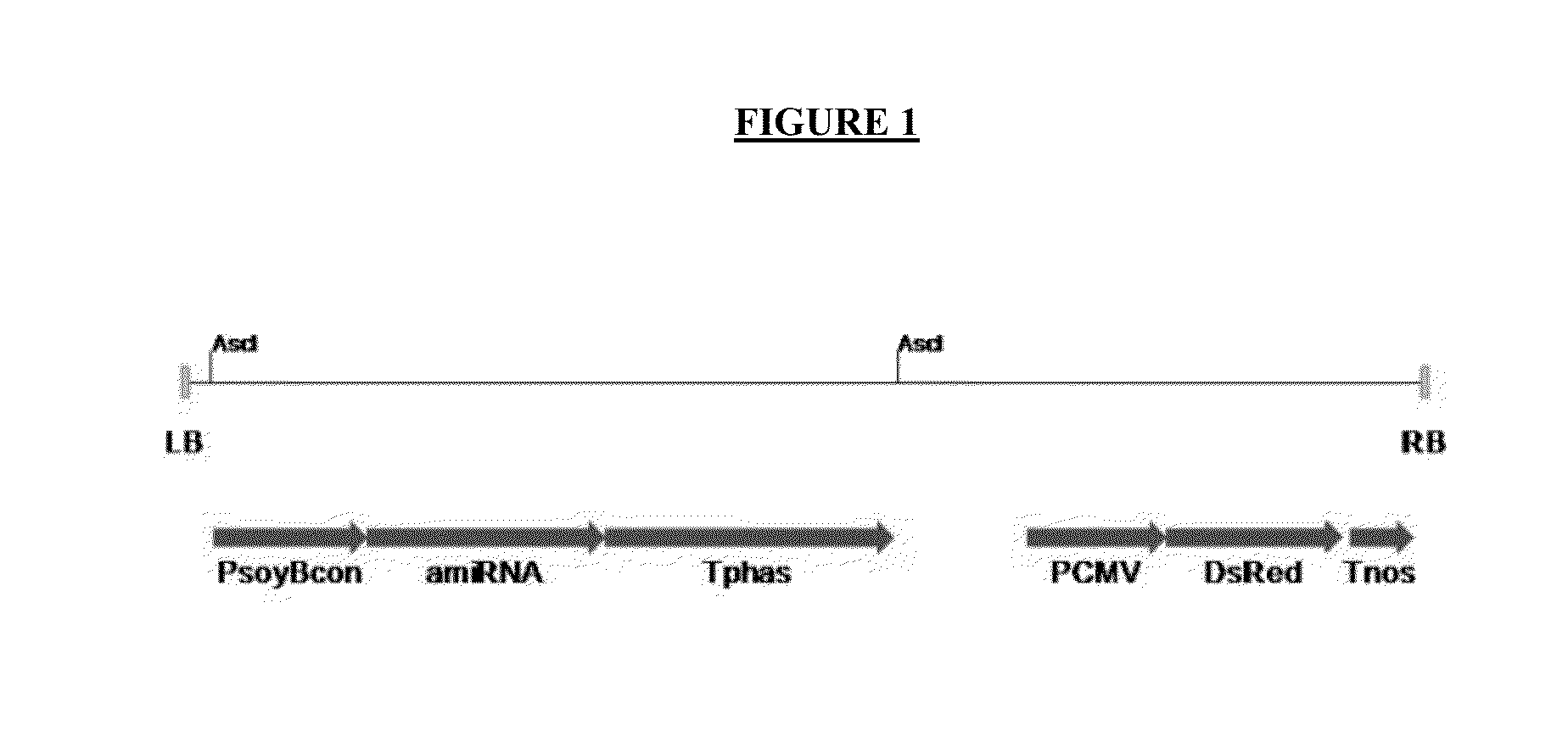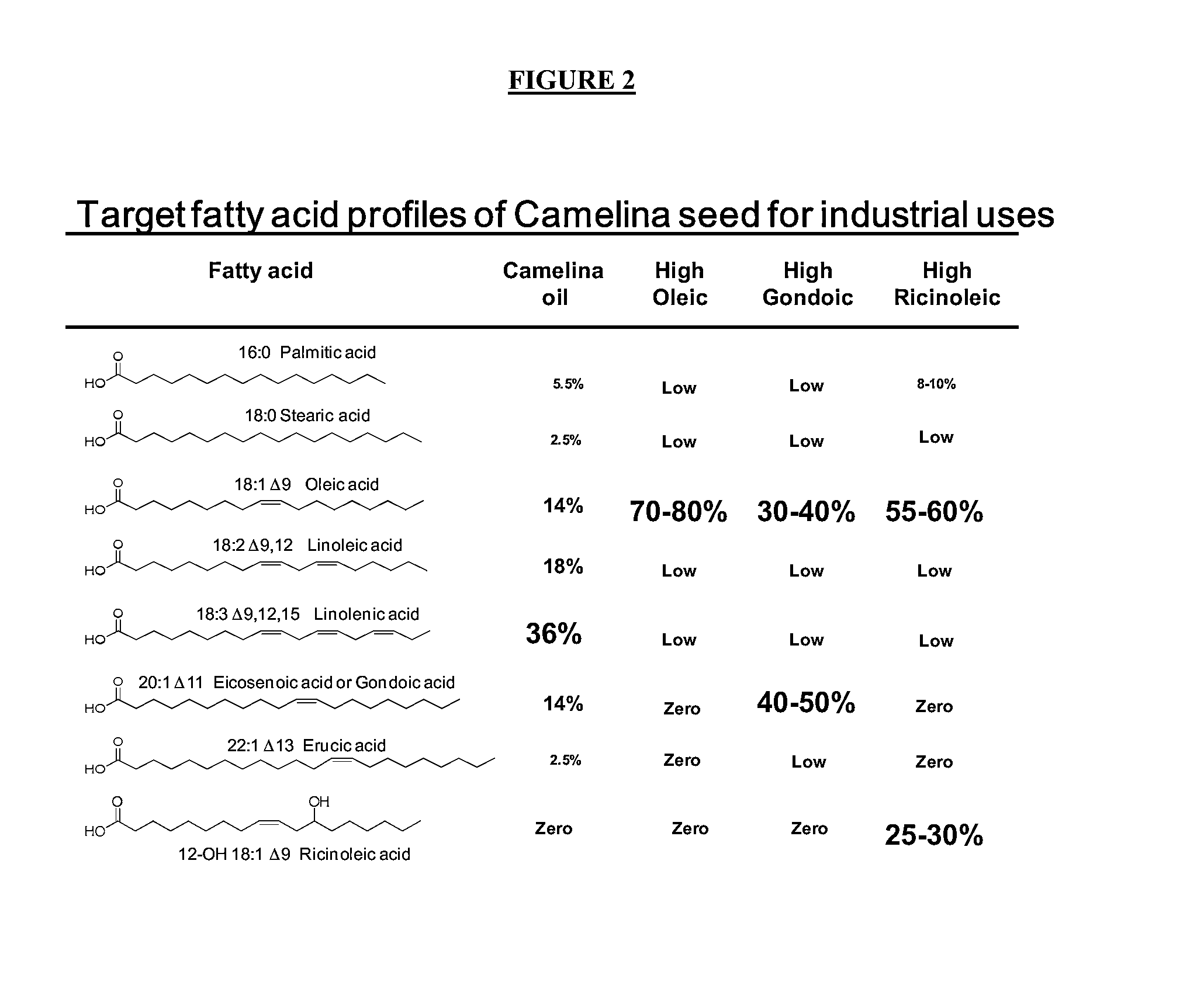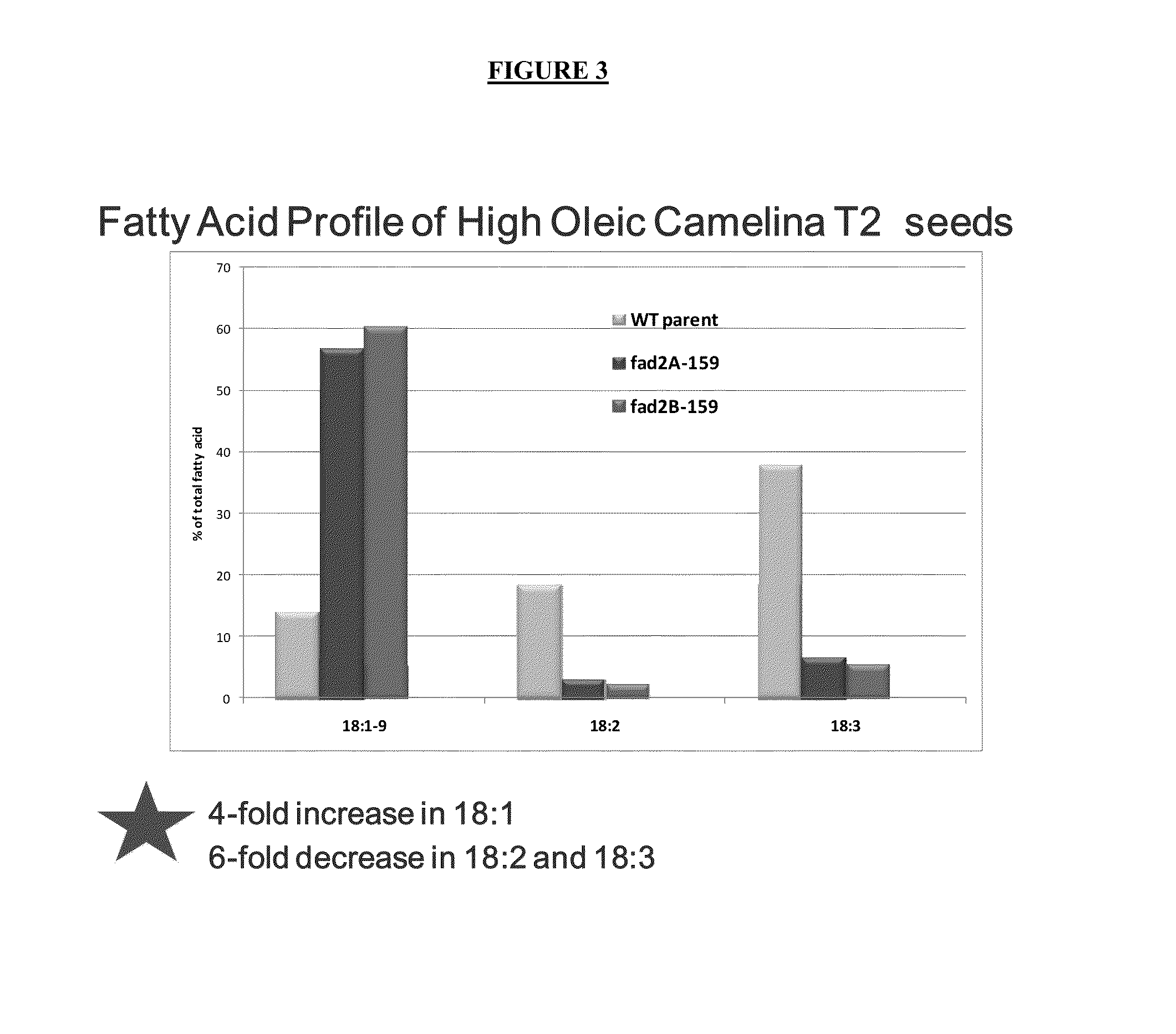Modifying the fatty acid profile of camelina sativa oil
a technology of camelina sativa and fatty acid composition, which is applied in the direction of fatty-oil/fat production, angiosperm/flowering plants, biochemistry apparatus and processes, etc., can solve the problems of low oxidative stability of pufa in refined oil, undesirable byproducts, and limits of i>camelina /i>oil in industrial applications, etc., to reduce densipolic acid, suppress expression, and modify the fatty acid profil
- Summary
- Abstract
- Description
- Claims
- Application Information
AI Technical Summary
Benefits of technology
Problems solved by technology
Method used
Image
Examples
example 1
Isolation of Fatty Acid Desaturases (FAD2 and FAD3) and Fatty Acid Elongase (FAE1)
[0110]A. Isolation of FAD2, FAD3, and FAE1 Sequences
[0111]RNA was isolated from a pool of green-yellow seed pods from C. sativa line CN101980 as previously described (Meisel et al., 2005) and resuspended in 100 μL DEPC-treated water. To remove any contaminating genomic DNA, the RNA was mixed with 350 μL RLT lysis buffer, 250 μL 96% ethanol and treated with DNAse I on a Qiagen RNeasy mini column according to the manufacturer's protocol (Qiagen, Hilden). cDNA was made from this RNA using the Superscript II First strand cDNA kit (Invitrogen, Carlsbad) according to the manufacturer's protocol. PCR primers were designed for amplifying the FAD2, FAD3, and FAE1 genes and are provided in Table 1 below.
TABLE 1 PCR Primers for Amplification of FAD2, FAD3 andFAE1 genes.Gene5′ Primer3′ PrimerFAD2CGTCAGCTCCAGAATCATGATTATGTGATGTGGGAAGTTAGGTGCAGGTGTTFAD3ATGGTTGTTGCTATGGACATTTAATTGATTTTAGACTTGTAACGTACAGAAGCGTFAE1ACACT...
example 2
amiRNA Constructs
[0122]Fatty acid biosynthetic gene sequences targeted for silencing by artificial microRNAs (amiRNAs) include FAD2, FAD3, and FAE1 genes. amiRNAs were designed to target both Arabidopsis and Camelina gene families and the corresponding genes targeted along with SEQ ID NOs are provided in Table 4.
TABLE 4Arabidopsis and Camelina fatty acid biosyntheticgenes targeted for gene silencingOrganismGenentaaTargetedFamilyGeneSEQ ID NOSEQ ID NOArabidopsisFad2At3g121204445Fad3At2g299804647FaeIAt4g345204849CamelinaFad2pLAT12-15051pLAT12-45253pLAT12-115455pLAT12-125657pLAT12-135859Fad3pLAT13-286061pLAT13-296263pLAT13-306465pLAT13-326667pLAT13-396869pLAT13-407071pLAT13-417273pLAT13-42rc7475FaeIpLAT14-4rci7677pLAT14-5rci7879pLAT14-7rci12pLAT14-1334
(1) Design of Artificial microRNAs
[0123]Artificial microRNAs (amiRNAs) that would have the ability to silence the desired target genes were designed largely according to rules described in Schwab R, et al. (2005) Dev Cell 8: 517-27. To su...
example 3
Camelina Transformation
[0134]A. Plant Material
[0135]Camelina sativa accession CN101980 was obtained from the Saskatoon Research Station, Agriculture and Agri-Food Canada. Plants were grown in the greenhouse at 22° C. with 16 h light, 8 h dark photoperiod with 20-60% (ambient) humidity and natural lighting enhanced with high pressure sodium lamps.
[0136]B. Agrobacterium tumefaciens strain GV3101 pMP90
[0137]The recombinant amiRNA vectors described above in Example 2 were introduced to Agrobacterium tumefaciens strain GV3101 pMP90 (Koncz and Schell, 1986) by the heat shock method. Transformed colonies were selected on Luria Broth / 1.5% agar with 50 mg / L Kanamycin and 25 mg / L Gentamycin.
[0138]C. Camelina Transformation
[0139]Camelina transformation was performed using a modification of the Arabidopsis floral dip method (Clough, 1998). Briefly, 5 mL cultures of Agrobacterium tumefaciens containing binary vector was grown in Luria broth overnight at 28° C. The 5 mL overnight culture was tran...
PUM
| Property | Measurement | Unit |
|---|---|---|
| length | aaaaa | aaaaa |
| humidity | aaaaa | aaaaa |
| ricinoleic acid | aaaaa | aaaaa |
Abstract
Description
Claims
Application Information
 Login to View More
Login to View More - R&D
- Intellectual Property
- Life Sciences
- Materials
- Tech Scout
- Unparalleled Data Quality
- Higher Quality Content
- 60% Fewer Hallucinations
Browse by: Latest US Patents, China's latest patents, Technical Efficacy Thesaurus, Application Domain, Technology Topic, Popular Technical Reports.
© 2025 PatSnap. All rights reserved.Legal|Privacy policy|Modern Slavery Act Transparency Statement|Sitemap|About US| Contact US: help@patsnap.com



